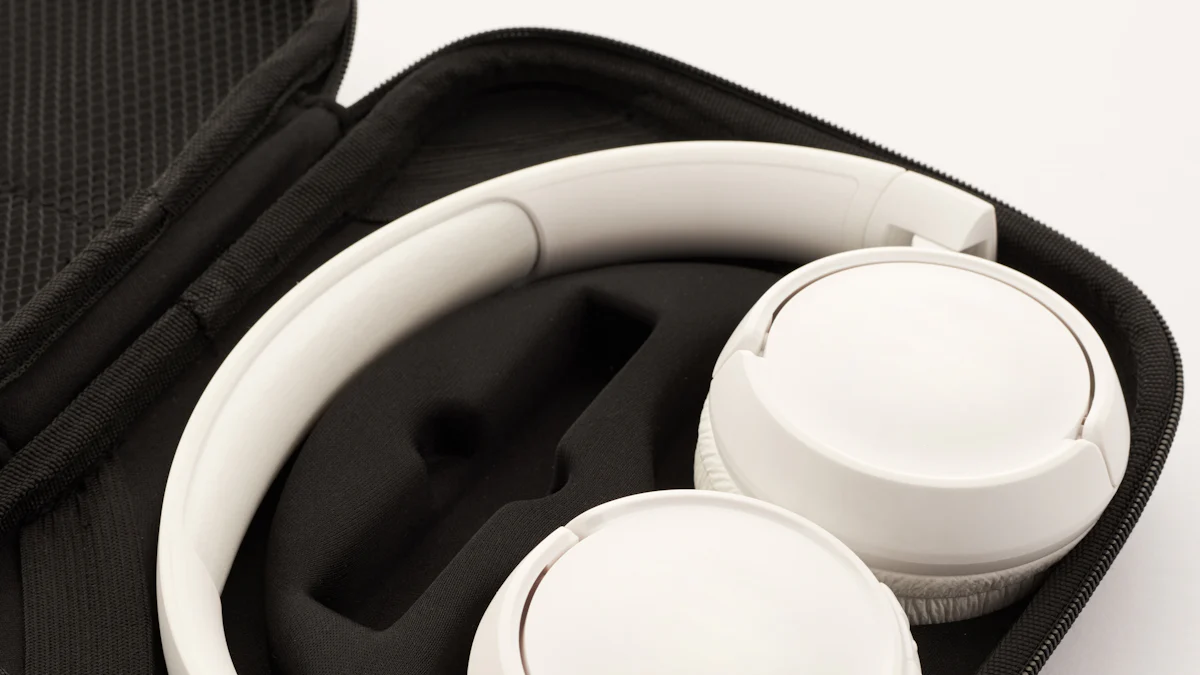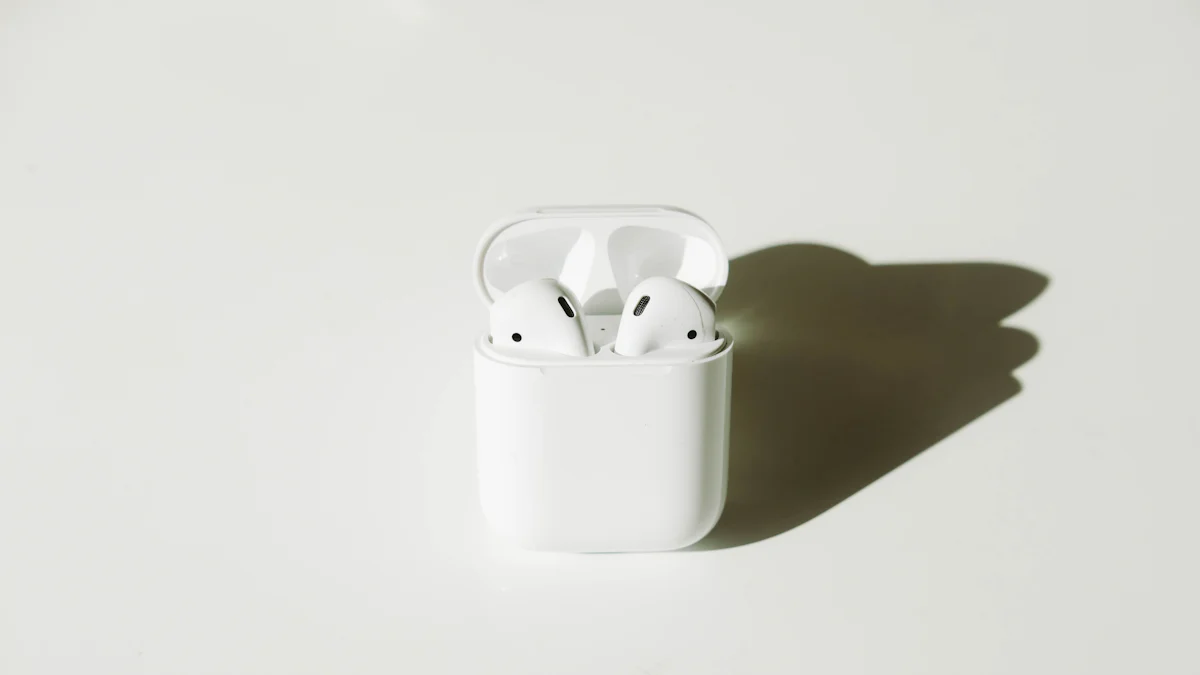Guide to Choosing the Best Noise-Cancelling Headset for Conference Calls

In today's fast-paced world, a professional headset featuring noise-cancelling microphone for conference calls is essential. You need clear communication during important calls. AI-powered noise cancellation technology plays a crucial role in achieving this clarity. It eliminates distractions like barking dogs or crying babies, allowing you to focus on the call. A good headset with AI-powered noise cancellation enhances your call experience by reducing ambient noise by up to 75%. This ensures that your voice remains the focal point during calls. Choosing the right headset is vital for effective communication, especially when you rely on calls for work.
Understanding Noise-Cancelling Technology

Technology Behind the Silence
Noise-cancelling technology transforms your listening experience by reducing unwanted ambient sounds. It uses advanced methods to detect external noise and counteracts it with an inverse sound wave. This process, known as active noise cancellation (ANC), creates a peaceful environment for your calls. Engineers have developed ANC to address the increasing levels of urban noise, providing a solution to the health risks associated with constant exposure to loud environments. By understanding this technology, you can appreciate how it enhances audio clarity and protects your hearing.
You will encounter two main types of noise-cancelling technologies: passive and active. Passive noise cancellation relies on physical barriers, like tight-fitting ear cups, to block external sounds. This method is similar to putting your fingers in your ears to muffle noise. On the other hand, active noise cancellation uses electronic circuitry to produce anti-noise signals that cancel out ambient sounds. While passive methods are effective for high-frequency noises, ANC excels at eliminating low-frequency sounds, such as engine hums or air conditioning noise. Understanding these differences helps you choose the right headset for your needs.
You will encounter two main types of noise-cancelling technologies: passive and active. Passive noise cancellation relies on physical barriers, like tight-fitting ear cups, to block external sounds. This method is similar to putting your fingers in your ears to muffle noise. On the other hand, active noise cancellation uses electronic circuitry to produce anti-noise signals that cancel out ambient sounds. While passive methods are effective for high-frequency noises, ANC excels at eliminating low-frequency sounds, such as engine hums or air conditioning noise. Understanding these differences helps you choose the right headset for your needs.
Noise-cancelling microphones play a crucial role in ensuring clear communication during conference calls. They filter out background noise, allowing your voice to remain the focal point. This technology significantly improves voice clarity by reducing distractions like keyboard typing or distant conversations. With a noise-cancelling microphones, you can maintain professionalism and focus during important calls. Additionally, these microphones enhance your overall call experience by ensuring that your message is heard loud and clear, even in noisy environments. By choosing a headset with a noise-cancelling microphone, you invest in effective communication and productivity.
Noise-cancelling microphones play a crucial role in ensuring clear communication during conference calls. They filter out background noise, allowing your voice to remain the focal point. This technology significantly improves voice clarity by reducing distractions like keyboard typing or distant conversations. With a noise-cancelling microphone, you can maintain professionalism and focus during important calls. Additionally, these microphones enhance your overall call experience by ensuring that your message is heard loud and clear, even in noisy environments. By choosing a headset with a noise-cancelling microphone, you invest in effective communication and productivity.
Tailoring Headset Choices to Purpose and Profession
Headsets for Remote Workers
Remote work demands a headset that balances comfort, functionality, and performance. You need a headset that supports long hours of use without causing discomfort. Look for models with adjustable headbands and cushioned ear pads. These features ensure a snug fit and prevent fatigue during extended calls. Telekonnectors, a leader in professional headsets, emphasizes the importance of comfort and noise cancellation. Their Sirius and Astral headsets offer advanced features tailored for remote work environments.
Noise cancellation remains crucial for remote workers. It minimizes distractions from household noises, allowing you to maintain focus. Choose headsets with active noise-cancelling microphones. These microphones enhance voice clarity by filtering out ambient sounds. This ensures your voice remains clear and professional during calls.
Consider wireless options for added flexibility. Wireless headsets allow you to move freely during calls, which can be beneficial if you need to multitask. Ensure the headset has a reliable battery life to last through your workday. Reading reviews and comparisons can help you find the best fit for your specific needs.
Headsets for Office Environments
In an office setting, headsets must cater to different needs. You require a headset that provides excellent audio quality and effective noise cancellation. This ensures clear communication in bustling office environments. Krisp, an expert in call center headsets, highlights the importance of choosing the right headset for office use. They recommend models with superior audio and microphone quality.
Dual-ear headsets often prove more effective in noisy offices. They block out distractions and help you focus on calls. Look for headsets with passive and active noise cancellation. This combination effectively reduces both high and low-frequency noises.
Compatibility with multiple devices is another key factor. Ensure the headset connects seamlessly with your office equipment. Options like USB, Bluetooth, or 3.5mm jack provide flexibility. Testing headsets in your typical work environment can help determine the best model for your needs. Prioritizing these factors ensures a seamless and productive work experience in the office.
Comparing Wired, Wireless, and Bluetooth Options

When selecting a headset for conference calls, you must consider the type of connection that best suits your needs. Each option—wired, wireless, and Bluetooth—offers distinct advantages and considerations.
Wired Headsets
Wired headsets, often referred to as Corded USB Headsets, provide a reliable and consistent audio experience. They connect directly to your device, ensuring zero latency and stable sound quality. This makes them ideal for tasks requiring precise audio, such as gaming or video editing. You won't have to worry about battery life, which means you can use them throughout your working day without interruptions.
Corded USB Zoom Headsets are particularly popular for their plug-and-play convenience. They connect via USB, offering compatibility with a wide range of devices. This makes them a practical choice for office environments where you need to switch between different computers or laptops. Additionally, wired headsets are generally more budget-friendly, making them an excellent option if you're conscious of price.
Wireless Headsets
Wireless headsets offer the freedom to move around during calls, which can be beneficial if you need to multitask. They connect to your devices via a wireless signal, providing a range that allows you to step away from your desk without losing connection. This flexibility is especially useful in dynamic work environments where mobility is key.
However, you should consider battery life when choosing wireless headsets. Ensure they have a reliable battery that can last through your working day. Brands like Logitech offer models with extended battery life, ensuring you stay connected without frequent recharging. Wireless headsets also support multiple device connections, allowing seamless transitions between your phone, computer, and other devices.
Bluetooth Headsets
Bluetooth headsets combine the benefits of wireless connectivity with the added advantage of compatibility across various devices. They provide a convenient way to connect to smartphones, tablets, and computers without the need for cords. This versatility makes them a popular choice for professionals who frequently switch between devices.
Bluetooth technology allows for a stable connection within a reasonable range, giving you the freedom to move around while staying connected. However, it's important to ensure that your Bluetooth headset offers good sound quality and noise cancellation features. Brands like Logitech provide Bluetooth headsets with advanced audio capabilities, ensuring clear communication during conference calls.
Brand Comparisons and Reliability
When choosing the best noise-cancelling headset for conference calls, understanding the features and reliability of popular brands is crucial. This guide will help you navigate the wide world of headsets, focusing on key brands known for their advanced noise cancellation technology and microphone quality.
Popular Brands and Their Features
-
Jabra: Known for its exceptional audio quality and durability, Jabra offers a range of headsets suitable for various professional environments. The Jabra Engage series, for instance, provides excellent noise cancellation and microphone quality, making it ideal for call centers and office use. Jabra's headsets often feature hybrid noise cancellation, ensuring clear communication even in noisy settings.
-
EPOS: A brand synonymous with high-quality audio solutions, EPOS delivers headsets that combine comfort and advanced technology. The EPOS Adapt and EPOS IMPACT series are particularly popular for their superior microphone noise cancellation and seamless connectivity options. These headsets are designed to enhance productivity by providing clear audio and reliable performance.
-
Orosound: With a focus on innovation, Orosound offers headsets like the Orosound Tilde and Orosound Tilde Pro, which are renowned for their Krisp Magic technology. This technology ensures that background noise is minimized, allowing for clear communication during calls. Orosound's headsets are also praised for their comfort and durability, making them a top choice for professionals.
-
Plantronics: A trusted name in the industry, Plantronics provides headsets that excel in both audio quality and comfort. Their models often feature passive noise cancellation, which effectively reduces ambient noise. Plantronics headsets are designed for long-term use, ensuring that you remain comfortable during extended conference calls.
-
SteelSeries: Known for its premium high-fidelity drivers, SteelSeries offers headsets that deliver exceptional sound quality. Their headsets come with advanced noise cancellation features and a retractable boom mic, ensuring that your voice is heard clearly. SteelSeries headsets are versatile, offering wired, wireless, and Bluetooth connectivity options.
Brand Comparison Table
To help you make an informed decision, here's a comparison table highlighting the key features of these popular brands:
| Brand | Key Features | Durability | Comfort | Price Range | |---------------|-------------------------------------------------------------------------------|------------|---------|-------------| | Jabra | Hybrid noise cancellation, excellent microphone quality, suitable for call centers | High | High | $$ | | EPOS | Advanced noise cancellation, seamless connectivity, comfortable design | High | High | $$ | | Orosound | Krisp Magic technology, clear communication, durable and comfortable | High | High | $$ | | Plantronics | Passive noise cancellation, long-term comfort, reliable performance | High | High | $ | | SteelSeries | Premium sound quality, versatile connectivity, retractable boom mic | High | High | $$ |
This collection of brands offers a variety of options to suit different needs and preferences. Whether you prioritize advanced noise cancellation, microphone quality, or comfort, these brands provide reliable choices for your professional headset needs. Remember to check the microphone quality and ensure that the headset aligns with your specific requirements before making a purchase.
Multi-Device Compatibility and Testing
Importance of Multi-Device Compatibility
In today's interconnected world, you need a headset that seamlessly connects to multiple devices. Whether you're using a PC, phone, or tablet, multi-device compatibility ensures you stay connected without interruptions. This feature allows you to switch between tasks effortlessly, maintaining productivity throughout your workday. A professional headset with multi-device pairing capabilities can connect simultaneously to two devices, providing flexibility and convenience.
Consider headsets that support multi-device pairing. These models offer great sound quality and noise cancellation, enhancing your communication experience. For instance, noise-canceling headphones with over 44 hours of continuous battery life ensure you remain connected across various devices. This capability is crucial for professionals who juggle multiple tasks and need reliable connectivity.
"Professional headsets with noise-canceling microphones and multi-device compatibility ensure clear communication in noisy environments and seamless transition between tasks."
Trying Before Buying
Testing a headset before purchasing is essential. It allows you to evaluate the comfort, sound quality, and noise cancellation features in your typical work environment. You should try different models to find the one that best suits your needs. Pay attention to the fit and comfort, especially if you plan to wear the headset for extended periods.
Consider the following steps when testing a headset:
-
Evaluate Comfort: Ensure the headset fits well and doesn't cause discomfort during long calls. Look for adjustable headbands and cushioned ear pads for added comfort.
-
Test Sound Quality: Listen to audio and make calls to assess the clarity and effectiveness of noise cancellation. This helps determine if the headset meets your communication needs.
-
Check Connectivity: Test the headset's ability to connect to multiple devices. Ensure it pairs easily with your PC, phone, or tablet, providing a seamless experience.
-
Assess Battery Life: For wireless models, check the battery life to ensure it lasts through your workday. Reliable battery performance is crucial for uninterrupted communication.
By trying before buying, you make an informed decision, ensuring the headset aligns with your specific requirements. This approach minimizes the risk of dissatisfaction and enhances your overall user experience.
Noise cancellation and microphone quality are crucial for effective communication during conference calls. To choose the best headset, consider these factors:
- Assess Your Needs: Identify your specific requirements, such as comfort for long calls or multi-device compatibility.
- Set a Budget: Determine how much you're willing to invest in a quality headset.
- Test Before Buying: Try different models to ensure they meet your comfort and audio clarity needs.
"Every frequent traveler swears by noise-cancelling headphones," highlighting their importance in reducing distractions. However, some users report discomfort, so testing is essential to find the right fit for you.
See Also
Selecting The Ideal 360-Degree Camera For Your Meetings
Finding The Right Webcam For Huddle Room Setup
Discovering The Best Video Camera For Meeting Spaces
